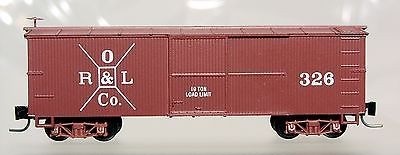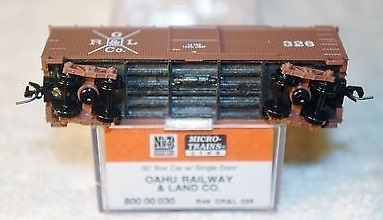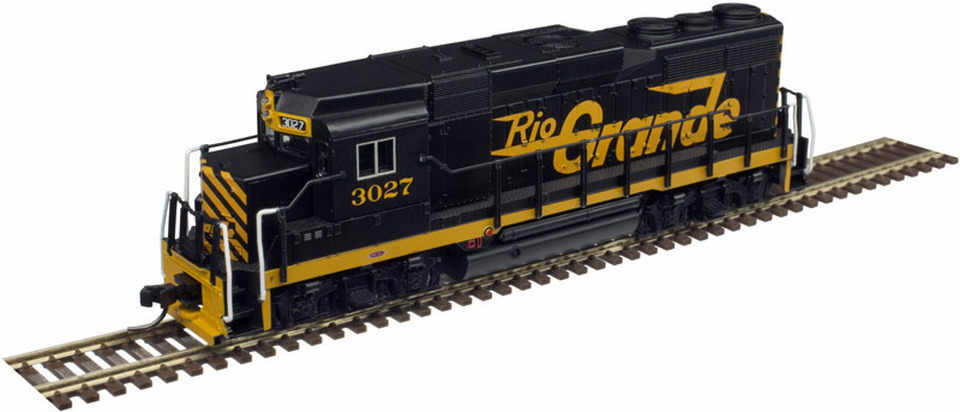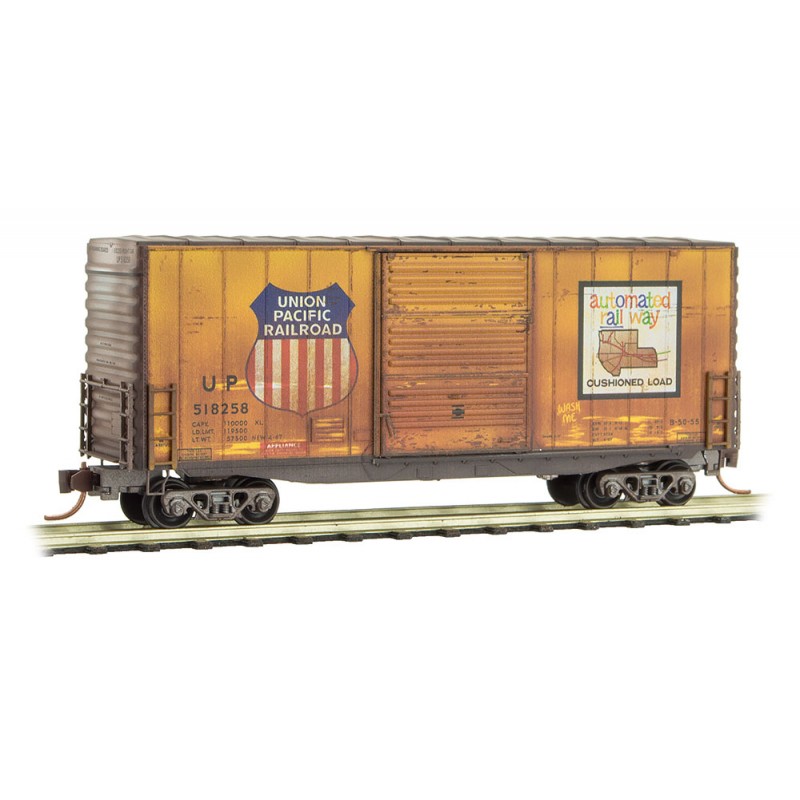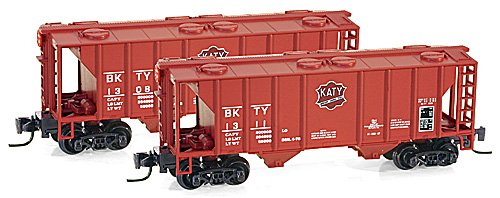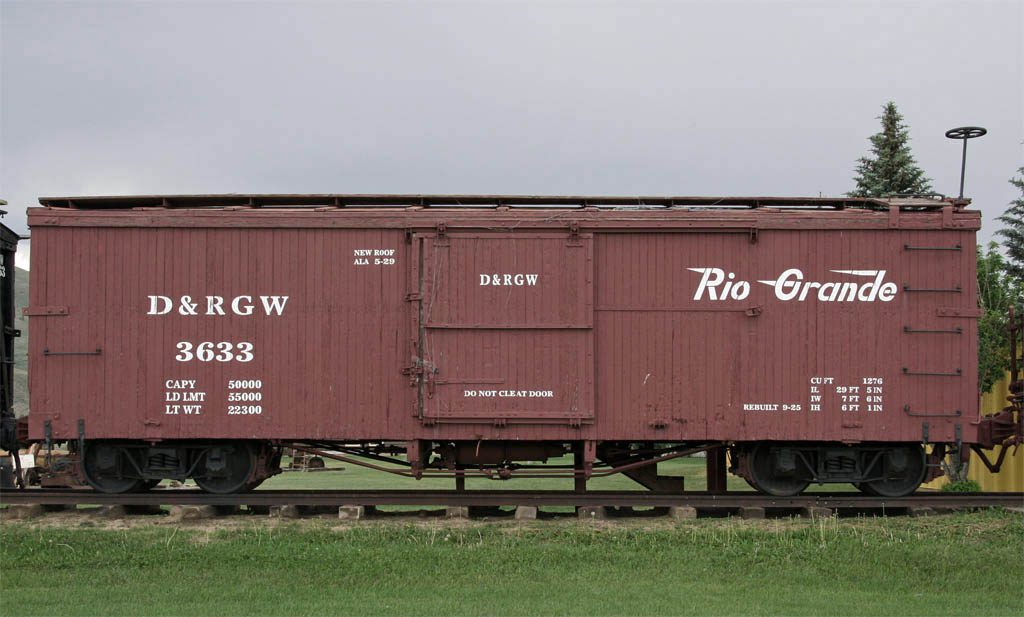Model Information: Micro-Trains introduced a Nn3 narrow gauge range in 1988 that includes a 30' boxcar, a 30' gondola, a 30' flat car and a caboose. The models are re-run occasionally since then.
Prototype History: A class of 750 boxcars, 30ft long and with a capacity of 25 tons, has been delivered to the D&RG by the American Car & Foundry in 1904; they were numbered from 3000 to 3749. In 1926, these boxcars were extensively rebuilt, keeping only a few iron parts from the original boxcars, but the new cars retained the same numbers. A large part of these boxcars remained in revenue service until the end of freight operations on the Rio Grande narrow gauge in 1968. Many boxcars of this class have been preserved today, including 45 on the Durango & Silverton Narrow Gauge Railroad, about twenty in their original condititon on the Cumbres & Toltec Scenic Railroad (plus 22 other converted to passenger cars), 9 at the Georgetown Loop Railroad and another 4 at the Colorado Railroad Museum. All the Rio Grande boxcars were completely made of wood (body and frame), except for numbers 3000-3749 which received a steel roof during their 1926 rebuilding.
Road Name History: 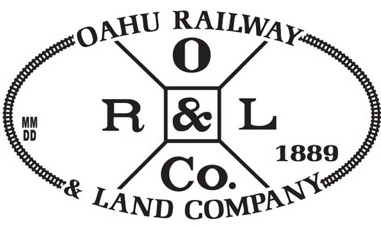 The ORwy&LCo was established in 1888 with the blessing of King Kalakaua to build a 3’ gauge railroad from Honolulu on the Hawaian Island of Oahu northwest around Pearl Harbor to a sugar cane operation at Ewa. The mainline was later extended around the western shore line to Kahuku. A network of branchlines were build north of Pearl Harbor to reach a large pineapple plantation at Wahiawa and the U.S. Army’s Schofield Barracks. Another branch reached Lualualei. Traffic was heavy. So much so that the Waipahu to Honolulu segment was double tracked and block signals were installed. While the Great Depression saw most railroads on the mainland falling into receivership, ORwy&LCo saw only a modest drop in passenger loadings while freight remained about the same. Then came the bombing of Pearl Harbor. They found themselves in the commuter railroad business with some trains as long as 20 cars. More narrow gauge passenger equipment from Boston Revere Beach & Lynn, Nevada County Narrow Gauge and Pacific Coast Railway was shipped over from the mainland. 18 months after the end of the war, traffic had collapsed. Cane and pineapple growers had switched to trucks and the passenger business was a shadow of its former self. At the end of 1947, most of the route was abandoned. A short segment in Honolulu remained to link canneries with the wharves. That operation ended in 1971.
The ORwy&LCo was established in 1888 with the blessing of King Kalakaua to build a 3’ gauge railroad from Honolulu on the Hawaian Island of Oahu northwest around Pearl Harbor to a sugar cane operation at Ewa. The mainline was later extended around the western shore line to Kahuku. A network of branchlines were build north of Pearl Harbor to reach a large pineapple plantation at Wahiawa and the U.S. Army’s Schofield Barracks. Another branch reached Lualualei. Traffic was heavy. So much so that the Waipahu to Honolulu segment was double tracked and block signals were installed. While the Great Depression saw most railroads on the mainland falling into receivership, ORwy&LCo saw only a modest drop in passenger loadings while freight remained about the same. Then came the bombing of Pearl Harbor. They found themselves in the commuter railroad business with some trains as long as 20 cars. More narrow gauge passenger equipment from Boston Revere Beach & Lynn, Nevada County Narrow Gauge and Pacific Coast Railway was shipped over from the mainland. 18 months after the end of the war, traffic had collapsed. Cane and pineapple growers had switched to trucks and the passenger business was a shadow of its former self. At the end of 1947, most of the route was abandoned. A short segment in Honolulu remained to link canneries with the wharves. That operation ended in 1971.

Brand/Importer Information: Micro-Trains is the brand name used by both Kadee Quality Products and Micro-Trains Line. For a history of the relationship between the brand and the two companies, please consult our Micro-Trains Collector's Guide.
Manufacturer Information:  Micro-Trains Line split off from Kadee Quality Products in 1990. Kadee Quality Products originally got involved in N-Scale by producing a scaled-down version of their successful HO Magne-Matic knuckle coupler system. This coupler was superior to the ubiquitous 'Rapido' style coupler due to two primary factors: superior realistic appearance and the ability to automatically uncouple when stopped over a magnet embedded in a section of track. The success of these couplers in N-Scale quickly translated to the production of trucks, wheels and in 1972 a release of ready-to-run box cars.
Micro-Trains Line split off from Kadee Quality Products in 1990. Kadee Quality Products originally got involved in N-Scale by producing a scaled-down version of their successful HO Magne-Matic knuckle coupler system. This coupler was superior to the ubiquitous 'Rapido' style coupler due to two primary factors: superior realistic appearance and the ability to automatically uncouple when stopped over a magnet embedded in a section of track. The success of these couplers in N-Scale quickly translated to the production of trucks, wheels and in 1972 a release of ready-to-run box cars.
Micro-Trains Line Co. split off from Kadee in 1990 to form a completely independent company. For this reason, products from this company can appear with labels from both enterprises. Due to the nature of production idiosyncrasies and various random factors, the rolling stock from Micro-Trains can have all sorts of interesting variations in both their packaging as well as the products themselves. When acquiring an MTL product it is very important to understand these important production variations that can greatly enhance (or decrease) the value of your purchase.
Please consult our Micro-Trains Collector's Guide

Micro-Trains Line Co. split off from Kadee in 1990 to form a completely independent company. For this reason, products from this company can appear with labels from both enterprises. Due to the nature of production idiosyncrasies and various random factors, the rolling stock from Micro-Trains can have all sorts of interesting variations in both their packaging as well as the products themselves. When acquiring an MTL product it is very important to understand these important production variations that can greatly enhance (or decrease) the value of your purchase.
Please consult our Micro-Trains Collector's Guide
Item created by: Alain LM on 2020-07-22 13:09:26
If you see errors or missing data in this entry, please feel free to log in and edit it. Anyone with a Gmail account can log in instantly.
If you see errors or missing data in this entry, please feel free to log in and edit it. Anyone with a Gmail account can log in instantly.


